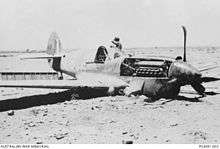No. 260 Squadron RAF
| No. 260 Squadron RAF | |
|---|---|
| Active |
August 1918 – 22 February 1919 22 November 1940 – 19 August 1945 |
| Country |
|
| Branch |
|
| Motto(s) | Latin: Celer et fortis ( Swift and Strong) |
| Insignia | |
| Squadron Badge | A sword and morning star |
| Squadron Codes | HS (Feb 1942 – Aug 1945) |
No. 260 Squadron RAF was a Royal Air Force squadron formed as a reconnaissance and anti–submarine unit in World War I and a fighter unit in World War II.
History
Formation and World War I
No. 260 Squadron Royal Flying Corps was formed on 25 July 1918 and operated DH.6s from Westward Ho, Devon on anti-submarine patrols and disbanded on 5 March 1919.
Reformation in World War II
The squadron reformed on 22 November 1940 at RAF Castletown, Scotland and operated Hawker Hurricanes. It then moved to Egypt and operated Curtiss Kittyhawk fighter bombers over the western desert. The squadron then advanced with the Eighth Army into Tunisia. With the North African Campaign over it then moved to Sicily following Operation Husky. As the allied forces advanced into Italy it converted to the North American P-51 Mustang and it disbanded at Lavariano on 19 August 1945.
Aircraft operated

| From | To | Aircraft | Variant |
|---|---|---|---|
| Aug 1918 | Feb 1919 | Airco DH.6 | |
| Nov 1940 | Feb 1942 | Hawker Hurricane | I |
| Feb 1942 | Mar 1942 | Curtiss P-40 Tomahawk | II |
| Feb 1942 | Sep 1942 | Curtiss P-40 Kittyhawk | I |
| Jun 1942 | May 1943 | Curtiss P-40 Kittyhawk | IIA |
| Dec 1942 | Mar 1944 | Curtiss P-40 Kittyhawk | III |
| Apr 1944 | Aug 1945 | North American P-51 Mustang | III |
| Jun 1945 | Aug 1945 | North American P-51 Mustang | IV |
2012 aircraft recovery in Egypt
In May 2012, CNN reported a Polish oil company worker in Egypt discovered a crash-landed 260 Sqn P-40 aircraft presumably piloted by Flt Sgt Dennis Copping, who went missing on 28 June 1942 and was never heard from again. Copping became disorientated while ferrying the P-40 and flew in the wrong direction; evidence at the crash site indicates Copping survived the landing and died in the desert. British authorities hope to bring the remarkably well-preserved plane back to the RAF Museum in London.[2]
References
- ↑ C.G.Jefford (1988). RAF Squadrons. UK Airlife Publishing. ISBN 1-85310-053-6.
- ↑ Silverleib, Alan (11 May 2012). "British WWII fighter found in Egyptian desert". CNN. Retrieved 11 May 2012.
External links
| Wikimedia Commons has media related to No. 260 Squadron RAF. |
